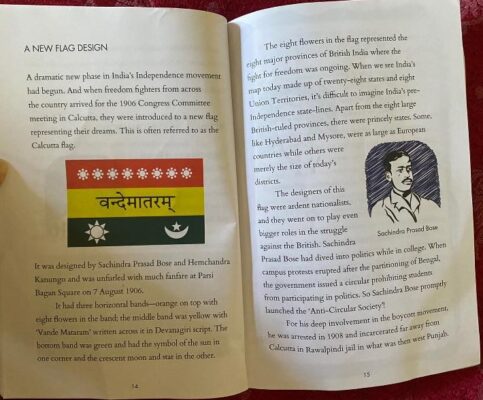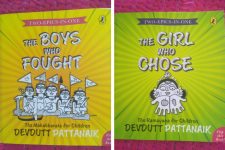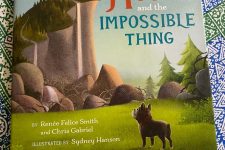Kavitha Mandana has written a series of books that provide insights into India’s rich history, by exploring facts and interesting stories behind some of the symbols of our National identity. Some of the books available in this series are:
The Story of India’s National Emblem
The Story of India’s National Flag
The Story of India’s National Anthem
The Story Of India’s National Symbols
Title: The Story of India’s National Anthem
Written by: Kavitha Mandana
Illustrations by: Dhwani Ved
Published by: Talking Cub (an imprint of Speaking Tiger Books)
Type: Paperback
Length: 72 pages
Age recommendation: 8 years onwards
Author Kavitha Mandana crafts a book brimming with fascinating yet lesser known facts about our National anthem. Most of us know about the Bengali literary stalwart who wrote the anthem but not more than that.
The book starts with an introduction to Rabindranath Tagore’s life- how an aristocratic Bengali boy immersed himself into literature and the Indian Freedom Movement.
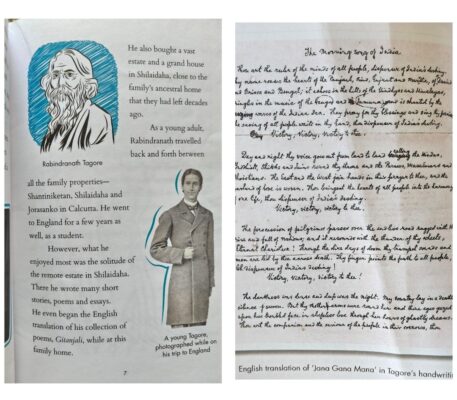
The awe-inspiring story of Jana Gana Mana (which was called the Morning Song of India) was truly enlightening. It had the power to unite and rouse a diverse nation like ours, to fight against the British.
There are beautiful illustrations by Dhwani Ved which will transport you back into history and numerous photographs from the archives as well – including one of Tagore’s hand-written notes of the English translation of ‘Jana Gana Mana’. The book also covers how Tagore’s words had to cross language barriers (from Bengali to English and Hindi) and had to be set to music.
The hugely popular ‘Vande Mataram’ was touted to be the national anthem but it was replaced by ‘Jana Gana Mana’ for a very important reason – read this book to find out why!
The author also covers how music played a galvanizing role in the freedom struggle: the power of the gramophone playing patriotic ‘anti-national’ speeches by the imprisoned leaders, the role of national songs and power of a secret underground Radio station!
Each page was brimming with amazing facts and I loved learning more about the Freedom struggle!
Kavitha Mandana also writes about other patriotic songs as well as enlightening snippets about the anthems of other countries (Did you know which country has the oldest national anthem?)
In times like these, this book is sure to be a shot in the arm for the millennials (and us, adults) to be reminded of how many sacrifices were made to achieve independence. This book with its rani pink cover is bound to have you brimming with pride about the tricolour.
A huge shout out to the wonderful Kavitha Mandana for writing this book (and the others in this series) to ensure the freedom struggle stories aren’t forgotten in history books!
A resounding recommendation for adults and kids to read this book! Jai Hind!
Should you wish to know more about our National Anthem, you might want to order the book from Amazon (kbc affiliate link),
CLICK & BUY NOW!A book that has made history so interesting and easy to understand for the little ones!
Title: The Story of India’s National Emblem
Length: 64 pages
Age recommendation: 7/8 years onwards (but will require an adult to explain some of the historical aspects)
Amardeep has shared the inside pages of this book here in the kbc facebook group. Excerpts from her review:
While revising for his GK assessment, Neil came across a statement – there are four lions on India’s national Emblem. Naturally, this stirred a host of questions in him – what is our national emblem, why does it have lions, why four, and why not four tigers, or four butterflies, or four birds?!
Thankfully, kbc had sent us a beautiful book a few weeks ago for review, that was perfect to answer this question. The story of India’s National Emblem by Kavitha Mandana.
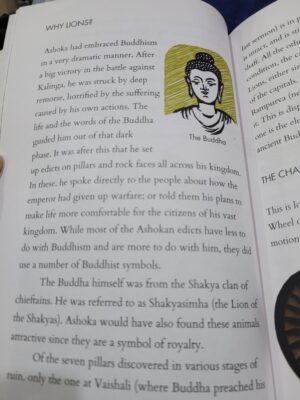
The book starts with a story from just before independence – July 1947. The author narrates how during the drafting of our constitution, one person noticed that the official envelopes still carried the UK emblems. This was problematic, obviously. Here started the need to have our own emblem. But why the four lions, sitting atop a chakra?
All of this is explained beautifully in the book. Each lion has a meaning, and together, the emblem stands for a peaceful India, that looks to grow internationally with courage and confidence, without losing the values of truth and honesty.
The book allowed me and Neil to have a huge discussion not only about the National Emblem but also about varied other topics that the book touches like:
– partition of India, including the fact that current Bangladesh was initially a part of Pakistan.
– Buddhism, and the story of Buddha, including serving only family vs serving entire humanity.
– Ashoka, and the Ashokan period
If you have a cuirous child who wants to know more about our wonderful heritage, you might want to order the book from Amazon (kbc affiliate link),
CLICK & BUY NOW!A book that takes us back to the time of Britain’s rule in India and teaches us all about the history of this wonderful symbol of peace and courage.
Title: The Story of National Flag
Length: 64 pages
Age recommendation: 7/8 years onwards
This book takes us through the freedom struggle of India and how different people played their part to free India and in the process shaped up the flag that we see today. It all started with the establishment of the British East India Company in India, which led to continuous wars with the kings and rulers. Thus, a need to have a unified symbol to symbolise the struggles and hardships faced by people was felt. This is how the inception of flag started.
Not many people know about the Calcutta flag, one of the first flags of our country. It was designed by freedom fighters Sachindra Prasad Bose and Hemchandra Kanungo. It featured three different colours-orange, yellow and green with ‘vandemataram’ written across in Devanagari script. Starting from the Calcutta flag, the flag went through a series of changes and evolved into the tricolour we know and love today. Many historical figures contributed to shaping the flag into what it is today, including Gandhiji with the introduction of Charkha and Sister Nivedita with an exquisite design using the colours red and yellow, along with a vajra at the centre.
The book is conceptualised beautifully because it just doesn’t just tell you the importance of the flag while touching upon the major milestones in India’s freedom struggle.
Pick up this amazing book and know all about the creation of our beloved tricolour. The illustrations are truly a sight to behold and the writing is simple yet beautiful.
To order the book from Amazon (kbc affiliate link),
CLICK & BUY NOW!A Fascinating Book for history enthusiasts!
Title The Story Of India’s National Symbols
Length: 64 pages
Age recommendation: 8/9 years onwards
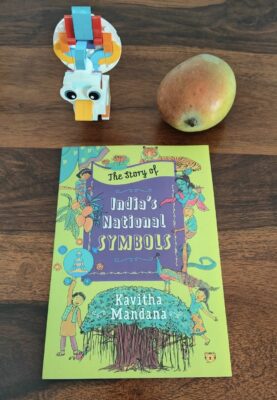
Pooja reviewed this one and shared inside pages in the kbc fb group here. Excerpts:
I’m a big history enthusiast, so when Asha ji suggested that I review a book on Indian National Symbols, I was genuinely excited to read it and dive deeper into our rich heritage. The book walks the reader through our various national symbols, explaining how and why each of the below ones were chosen:
• National Animal – Bengal Tiger
• National Flower – Lotus
• National Fruit – Mango
• National Bird – Peacock
• National Tree – Banyan
• National Reptile – Indian Cobra
• National Aquatic Animal – Gangetic Dolphin
Did you know that India also has a National Microbe? I was quite surprised to learn about it! What’s even more fascinating is that the selection process involved children across the country voting through a booth set up in a special train. Isn’t that amazing?
What I really appreciated about the book is how thoroughly the author, Kavitha, explains the background behind each symbol. She highlights the detailed process experts went through to finalize each one—taking into account cultural significance, Indian mythology, religion, and their ability to inspire the nation. I had no idea that there were multiple candidates for each symbol and that such a rigorous vetting process was involved.
My favorite chapter was about how the lion lost its status as the National Animal 25 years after independence, giving way to the tiger. It was heartbreaking to read about the extensive hunting practices from the 18th century onwards, which caused a sharp decline in the lion population—leaving just a handful in the Gir forests of Gujarat by the 1970s. The author also discusses the vital role played by Nawab Mahabat Khanji II of Junagadh (of the Babi dynasty) and his successors, who banned lion hunting being instrumental in conserving the species in his region.
She also delves into the purpose behind having national symbols which was to reclaim our identity after centuries of colonization.
We even had some engaging dinner-table conversations about the “whys” behind each symbol. I highly recommend this book to every child (and adult!) to understand the deep thought and research that went into selecting each meaningful and inspiring national symbol.
To order the book from Amazon (kbc affiliate link),
CLICK & BUY NOW!Disclaimer: Sowmya, Amardeep, Achira, Pooja and their children are a part of the #kbcReviewerSquad and received these books as review copies from the publisher via kbc.
[Note from Team Kids Book Café: For your convenience, affiliate links (MARKED IN PINK) to some of the book titles & images have been added to enable you to buy the books from AMAZON, should you wish to! A very small amount of money comes to kidsbookcafe.com when you purchase a book via the amazon affiliate link provided (at absolutely no extra cost to you!). Do let us know if you need information about other children’s books by writing to asha@kidsbookcafe.com.]



